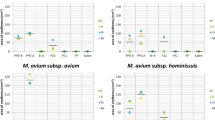Summary
British cattle were inoculated with lumpy skin disease (Neethling) virus and their clinical signs observed over a three week period. Elevation of body temperature following infection was not found to be a consistent feature, and even in severe cases was limited to a peak temperature of 41 °C. Generalised lesions were seen 9–14 days post infection (p.i.), and the development of generalised infections did not appear to be dose related. Following intradermal inoculation lesions were detected from day 2 p.i. and first appearance and severity of local reaction appeared to be related to dose. Virus isolation was carried out on ocular, nasal and saliva swabs, and on buffy coat preparations. A transient viraemia was detected in two of eleven animals that did not show generalized signs; virus was not isolated from the secretions of seven animals without generalised signs. Virus was isolated from the peripheral secretions of an animal with generalised disease between 9 and 15 days p.i. and viraemia was detected in each of five animals with generalized signs. Delayed-type hypersensitivity reactions following intradermal inoculation of immune cattle with LSDV were found to be maximal at 24 h after challenge.
Similar content being viewed by others
References
Braverman Y, Yeruham I, Davidson M (1993) Retrospective study on the epidemiology of the first lumpy skin disease outbreak in Israel in 1989. IXth International Congress of Virology, Glasgow, Scotland, 8–13th August 1993 [Abstracts]
Carn VM, Kitching RP (1994) An investigation of possible routes of infection with lumpy skin disease virus (Neethling). Epidemiol Infect (in press)
Capstick PB, Coackley W (1962) Lumpy skin disease: the determination of the immune state of cattle by an intradermal test. Res Vet Sci 3: 287–291
Davies FG (1981) Lumpy skin disease. In: Gibbs EPJ (ed) Virus diseases of food animals 11. Academic Press, London, pp 751–764
Davies F (1991) Lumpy skin disease, an African capripox virus disease of cattle. Br Vet 147: 489–503
Dumbell KR, Wells DGT (1982) The pathogenicity of variola virus. A comparison of the growth of standard strains of variola major and variola minor viruses in cell cultures from human embryos. J Hyg 89: 389–398
Fenner F, Day MF, Woodroofe GM (1952) The mechanism of the transmission of Myxomatosis in the European rabbit (Oryctolagus cuniculus) by the mosquitoAedes aegypti. Aust J Exp Biol Med Sci 30: 139–152
Fenner F, Henderson DA, Arita I, Jezek Z, Ladnyi ID (1988) In: Smallpox and its eradication. WHO, Geneva
Green HF (1959) Lumpy skin disease—its effect on hides and leather and a comparison in this respect with some other skin diseases. Bull Epiz Dis Af 7: 63–74
Haig DA (1957) Lumpy skin disease. Bull Epiz Dis Af 5: 421–430
Karber G (1931) Beitragzur kollektiven Behandlung pharmakologischer Reihenversuche. Arch Exp Pathol Pharmakol 162: 480–483
Kitching RP, Taylor WP (1985) Transmission of capripoxvirus. Res Vet Sci 39: 196–199
Kitching RP, Bhat PP, Black DN (1989) The characterization of African strains of capripoxvirus. Epidemiol Infect 102: 335–343
Krinsky WL (1976) Animal disease agents transmitted by horse flies and deer flies (Diptera: Tabanidae). J Med Entomol 13: 225–275
Macowan KDS (1959) Observations on the epizootiology of lumpy skin disease during the first year of its occurrence of Kenya. Bull Epiz Dis Afr 7: 7–20
Marshall ID (1959) The influence of ambient temperature on the course of myxomatosis in rabbits. J Hyg 57: 484–497
Plowright W, Ferris RD (1958) The growth and cytopathogenicity of sheep-pox virus in tissue cultures. Br J Exp Pathol 39: 424–435
Plowright W, Macleod WG, Ferris RD (1959) The pathogenesis of sheep pox in the skin of sheep. J Comp Pathol 69: 400–413
Prozesky L, Barnard BJH (1982) A study of the pathology of lumpy skin disease in cattle. Onderstepoort J Vet Res 49: 167–175
Rao AR, Jacob ES, Kamala Kshi S, Appaswamy S, Bradbury (1968) Epidemiological studies in smallpox. A study of intrafamilial transmission in a series of 254 infected families. Ind J Med Res 56: 1826–1854
Roberts JA (1964) Enhancement of the virulence of attenuated ectromelia virus in mice maintained in a cold environment. Aust J Exp Biol Med Sci 42: 657–666
Von Pirquet CE (1911) Allergy. Arch Int Med 7: 259–288
Webb G (1990) Studies on the mechanical transmission of animal viruses by biting flies. Ph.D. Thesis, Council of National Academic Awards.
Weiss KE (1968) Lumpy skin disease virus. Virol Monogr 3: 111–131
Author information
Authors and Affiliations
Rights and permissions
About this article
Cite this article
Carn, V.M., Kitching, R.P. The clinical response of cattle experimentally infected with lumpy skin disease (Neethling) virus. Archives of Virology 140, 503–513 (1995). https://doi.org/10.1007/BF01718427
Received:
Accepted:
Issue Date:
DOI: https://doi.org/10.1007/BF01718427




